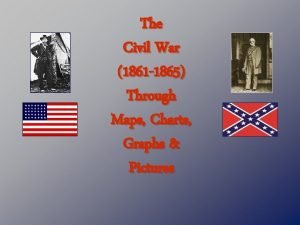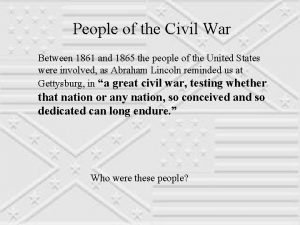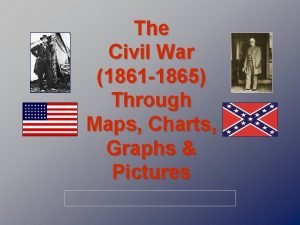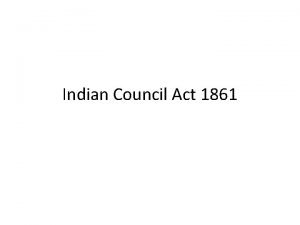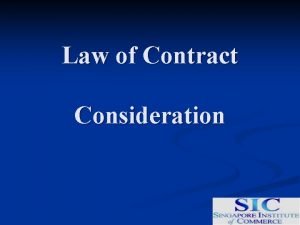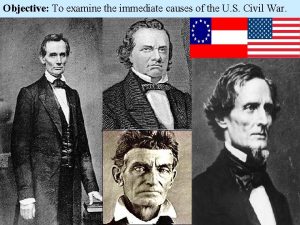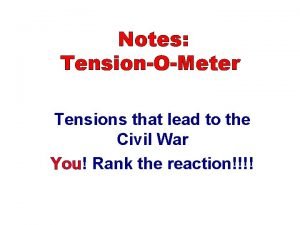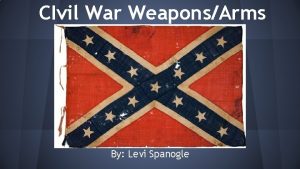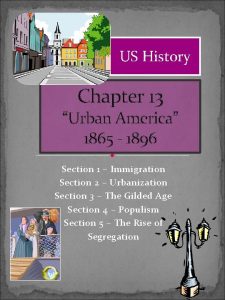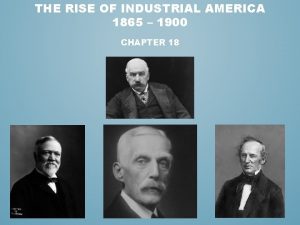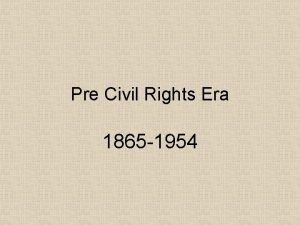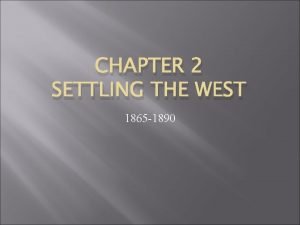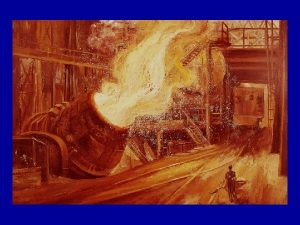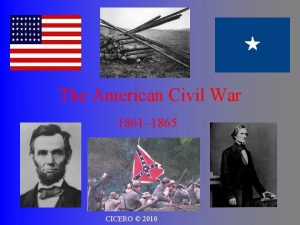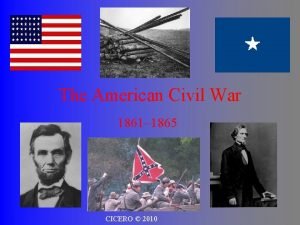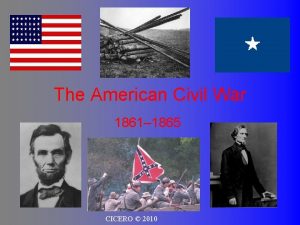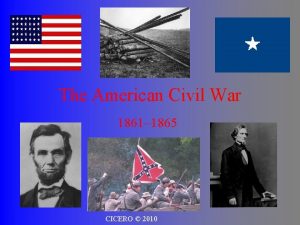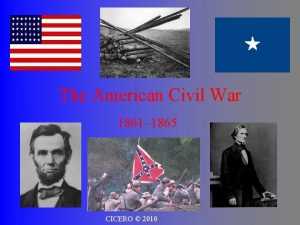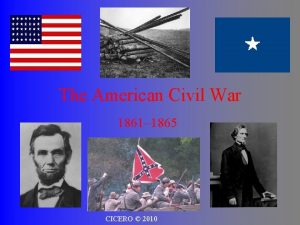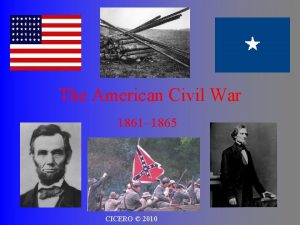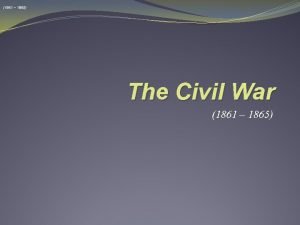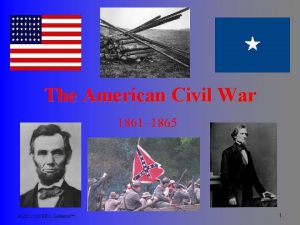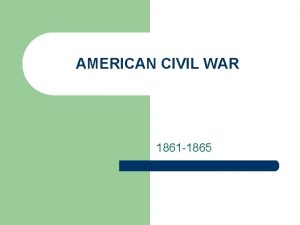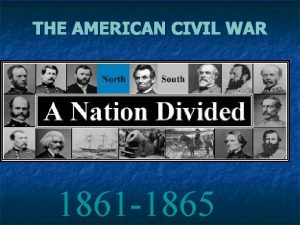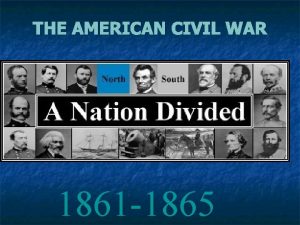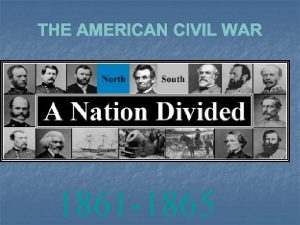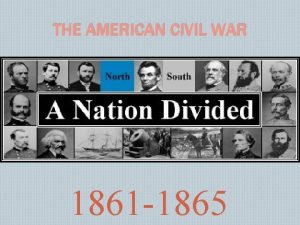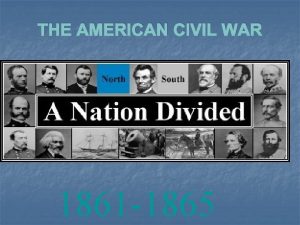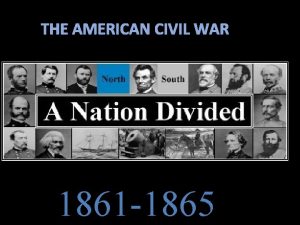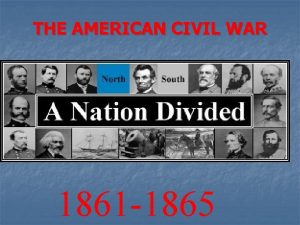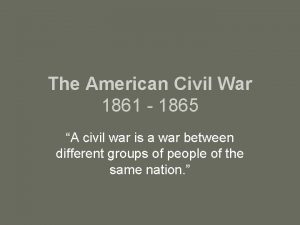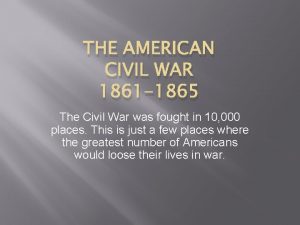The American Civil War 1861 1865 CICERO 2010


























- Slides: 26

The American Civil War 1861– 1865 CICERO © 2010

Causes • Many people agree slavery was the main cause for the war. • In addition, sectional differences led to conflicts. • different lifestyles and cultures. • Differences in the economic life • Southern states also began to question the extent of the federal government’s power. CICERO © 2010

Abolitionist Movement Abolitionists wanted slaves to be freed. CICERO © 2010

How does this painting, Tragic Prelude, represent the debate over slavery prior to the Civil War?

The Leaders Union Confederacy • Abraham Lincoln was the sixteenth President of the United States • Jefferson Davis was President of the Confederate States of America. • Mexican War- officer in the United States Army, served as the United States Secretary of War. CICERO © 2010 • Opposed the expansion of slavery.

The Generals Ulysses S. Grant Robert E. Lee William T. Sherman Thomas Jackson George Meade James Longstreet George B. Mc. Clellan CICERO © 2010 James E. B. Stuart

Strategies Anaconda Plan • Suggested by General Winfield Scott to halt Southern trade • Enabled the North to control the Mississippi River. • Army would divide and isolate sections of the South and capture its vital cities and the capital in Richmond, Virginia. • North’s strategy kept pressure on Lee’s army to weaken their numbers. King Cotton • adopted a defensive strategy • attempted to secure alliances with more powerful countries such as Britain and France. • As the war continued, the Southern strategy became one of evading the Union army and prolonging the war CICERO © 2010

Weapons of the Civil War canister shot artillery projectile rifled barrel officer’s sword Springfield rifle, 1861 (Union) Although the Union used many types of rifles, this was the most common. British Enfield rifle, 1853 (Confederacy) minié ball Although the Confederacy used many types of rifles, this was the most common. CICERO © 2010

Uniforms • At the beginning of the Civil War, states provided uniforms • Uniforms were in a variety of colors- led to massive confusion on the battlefield • As the war continued, both sides chose a single color for their uniforms : – Union- Blue -Confederacy- Gray CICERO © 2010

Major Battles of the Civil War CICERO © 2010

Fort Sumter April 12, 1861 • 1 st Shots of the Civil War • Morning, April 12 th, 1861 Confederates launched an attack – Union returned fire, but were ineffective • Fort surrendered a day later; 1 Confederate soldier and 4 Union soldiers killed CICERO © 2010 South Carolina

Virginia First Bull Run/Manassas July 21, 1861 • The First Battle of Bull Run took place on July 21, 1861. • lasted about five hours. • Confederate forces began to retreat due to losses, except General Thomas “Stonewall” Jackson continued to fight • Union casualties were high, almost three thousand; and the Confederates suffered two thousand casualties. CICERO © 2010

Shiloh Tennessee April 6 -7, 1862 • Battle of Shiloh raged from April 6 until April 7, 1862. • Union troops had found unprepared Confederate General • Confederates suffered many losses. • On the second day the Union army claimed ground • Confederacy had exceptional defense and stopped the Union CICERO © 2010

The War at Sea • Battle of the Ironclads also is known as the Battle of the Monitor and the Merrimack. • First naval battle between two ironclad ships • Neither side claimed victory in this battle • Ironclad, steam-driven ships were at a decisive advantage against wooden sailing vessels. CICERO © 2010

Antietam Maryland September 17, 1862 • The Battle of Antietam- fought on September 16– 18, 1862. • It was a confrontation between Union (Mc. Clellan) and Confederate (Lee) forces • Federal armies brutalized the Confederacy; the combined casualties were more than twentythree thousand. • The two sides fought to a standstill, and both armies withdrew. • Bloodiest Battle ever fought CICERO © 2010

Fredericksburg December 13, 1862 • Fredericksburg was the site of a battle in December 1862. • Union General Burnside led a march on Richmond. • General Lee positioned his army, deploying snipers • Union soldiers were left in the open and became easy prey for Confederate troops. • Burnside had no choice but to retreat with the remnants of his army. CICERO © 2010 Virginia

Women in War: Clara Barton • Nurse to Union Troops • Nicknamed “Angel of the Battlefield” • Fought at Vicksburg and Antietam • Worked at the War Dept • Founded the Red Cross CICERO © 2010

The Emancipation Proclamation January 1, 1863 • President Abraham Lincoln issued the Emancipation Proclamation. • Plan to end slavery in the rebellious states. • The Confederate government claimed Lincoln could not issue laws over states in which he had no political control. CICERO © 2010

Vicksburg Mississippi May 2 -July 9, 1863 • The North and the South considered Vicksburg an important stronghold- gained control of the Mississippi River • Union General Ulysses S. Grant launched massive assaults on Vicksburg and terrorized the inhabitants. • Confederate General John Pemberton surrendered to Grant on July 3, 1863. CICERO © 2010

Gettysburg Pennsylvania July 1 -3, 1863 • Lee planned several attacks, including attacks at Peach Orchard and Devil’s Den. • The Union army fought back, repelling Confederate attacks and sending them back to Culp’s Hill. • Lee was relentless and sent his army back into battle, but to no avail. • Considered the Turning Point of the War CICERO © 2010

The Gettysburg Address November 19, 1863 Abraham Lincoln delivered this famous speech on November 19, 1863, to a crowd gathered at the dedication of Soldier’s National Cemetery in Gettysburg, Pennsylvania. The speech contains only two hundred seventy-two words, but it is considered one of the greatest speeches in American history. CICERO © 2010

Sherman’s March to the Sea November 15 -December 20, 1864 • Union General William T. Sherman already had captured Atlanta, but marched the rest of his army to the Atlantic Ocean • Sherman’s soldiers faced fewer than five thousand Confederate soldiers. As the Union army moved through the South, they destroyed train tracks by heating the rails and bending them into a bow. This became known as “Sherman’s Neckties” • Sherman’s troops burned buildings and infrastructures along the way, destroying many towns and cities. • Sherman’s troops defeated the depleted Confederate army and took Savannah on December 22, 1864. CICERO © 2010

Surrender at Appomattox Virginia April 9, 1865 • General Lee surrendered his Confederate army at Appomattox Court House, Virginia, on April 9, 1865. • Lee’s army had diminished, which contributed to Union General Grant’s many victories near the end of the war. • In a sign of respect, Grant allowed Lee to keep his saber and horse. CICERO © 2010

Assassination of Lincoln April 14, 1865 • He was killed on April 14, 1865, while attending a play at Ford’s Theatre in Washington, D. C. • Lincoln was watching Our American Cousin when John Wilkes Booth shot him in the back of the head. • Booth was a loyal Confederate, and he thought the Confederacy could triumph if Lincoln were dead. • Booth jumped off the balcony and broke his ankle, but managed to escape theater. • Lincoln died of his fatal wound the next morning. CICERO © 2010

Medal of Honor Winners William Carney • • 54 th Massachusetts's Regiment Sargent was shot down, he then carried the flag from then on Shot at and wounded Received Medal of Honor- 1 st African American Recipient Philip Bazaar • • Born in Chile, South America Union Navy, USS Santiago de Cuba Carried Dispatches during the Assault on Ft. Fisher 1 of 6 men who entered fort CICERO © 2010

Legacy of the War • The Civil War was the bloodiest war in American history. • It has been referred to as “The War Between the States, ” • More than 600, 000 Americans lost their lives, and countless others were wounded severely. • The Civil War led to passage of the Thirteenth, Fourteenth, and Fifteen Amendments to the United States Constitution. • These amendments outlawed slavery, granted African Americans United States citizenship, and granted African-American males the right to vote. CICERO © 2010
 Civil war 1861/1862
Civil war 1861/1862 Civil war 1861/1862
Civil war 1861/1862 Regionalism in literature
Regionalism in literature Why was the civil war considered the first modern war
Why was the civil war considered the first modern war Chapter 16 lesson 2 challenges to slavery
Chapter 16 lesson 2 challenges to slavery Who were abolitionists
Who were abolitionists India council act 1861
India council act 1861 Unionistička stranka 1861
Unionistička stranka 1861 Bolton v madden (1873)
Bolton v madden (1873) John brown poster
John brown poster Tensionometer
Tensionometer Springfield model 1861 rifle facts
Springfield model 1861 rifle facts Civil rights webquest
Civil rights webquest Urban america 1865 to 1896
Urban america 1865 to 1896 St helen’s smelting co v tipping (1865)
St helen’s smelting co v tipping (1865) The rise of industrial america 1865-1900
The rise of industrial america 1865-1900 Four features of industrial manufacturing (1865-1900)
Four features of industrial manufacturing (1865-1900) 15 th ammendment
15 th ammendment Industrialization (1865 to 1901 worksheet answers key)
Industrialization (1865 to 1901 worksheet answers key) Becoming a world power 1865-1917
Becoming a world power 1865-1917 What are characteristics of impressionism
What are characteristics of impressionism Chapter 20 becoming a world power notes
Chapter 20 becoming a world power notes Native clothing
Native clothing Al cruzar una planta de guisantes de flores purpura
Al cruzar una planta de guisantes de flores purpura Art history impressionism
Art history impressionism 1877-1865
1877-1865 Industrialization (1865 to 1901 worksheet answers key)
Industrialization (1865 to 1901 worksheet answers key)
